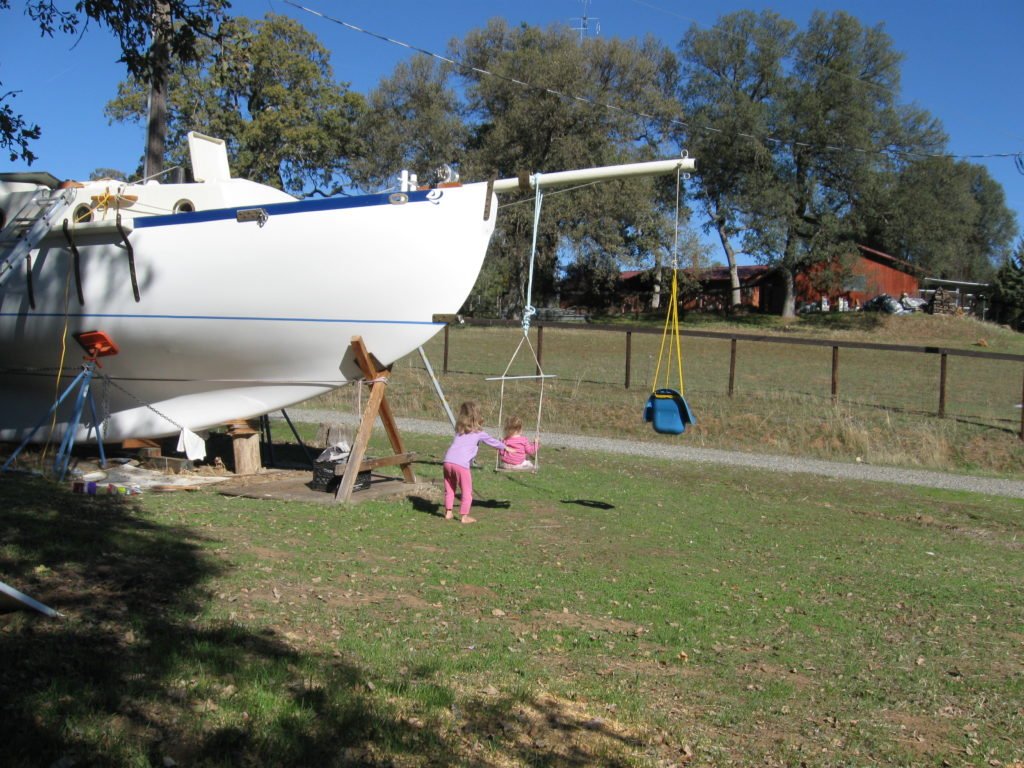It is telling, perhaps, of how uninteresting sanding is, that every time you get to move from one grit to the next finer is a red-letter occasion. Imagine, if you’re still reading this after that first sentence, getting to skip straight from 36-grit to 220! It happened like this: after leaving the dinghy faired and primed at the end of the last blog post, I did some light filling of pinholes with Bondo, scuffed the entire surface again with 220-grit, and laid on two heavy coats of high-build Duratek primer. In contrast to the black surfacing primer I’d been using, this was an eye-catching baby blue. Better yet, it filled all the 36-grit gouges that the black hadn’t been able to, and was almost a joy to sand.
This was the last chance to microscopically alter the shape of the hull; to make it as perfect as it is ever destined to get. To make the most of it, I secured a roll of sticky-back 220 grit sandaper, so I could sand with a two-foot board and not carve any hollows into it. That done, my shop-mate sprayed a final layer of black Duratek on for me—sprayed it very fine and carefully to avoid excessive “orange peel,” and I was ready for the final push: sanding down through all the grits from 220 to 800, and lastly buffing the duratek with a high-speed polisher and compound.
But let’s leave the dinghy glistering in black opulence for now and jump back to Ganymede’s cockpit, where I managed to get in a half day of fairing before the weather turned violently cold. It was only a half day because I spent the rest of it drilling out the rope-holes in the manrope holders on the cabintop. Originally I’d had a little tube of copper in the hole as a bushing for the manropes—which is what Ganymede has instead of handrails—and each end of the tubing was peened over to keep it in place. They had never looked perfectly tidy, and were going to look worse if I painted the cabin with them in place. So since they had to go for fairing and painting, and I remembered how hard it had been to put them in the first place, I’m replacing them by gluing a piece of fiberglass tubing in place. This can be faired in smooth and painted along with everything else, giving the cabintop (I trust) a cleaner look.
While I was out there with the proper sized hole saw, I drilled out the holes for the belaying pins as well, using a simple wooden jig to keep the saw centered on the hole. That day was my last chance at getting stuff done out there for a good while, since winter returned with alternate super-cold days or strong gales, and sometimes both at once, just for extra interest.
Fortunately, I still had more on my plate than I could handle back in the civilized warmth of the shop. It had seemed a good idea, when I was heaping project upon project on myself back in the fall, to build a new bowsprit. The old one is really heavy—I can barely stagger with it—and was never faired properly. It seemed that as long as fairing had to happen anyhow, I may as well fair a new spar as the old one.
The principal virtue of the original bowsprit was that I’d made it out of leftover materials, so it was basically free. The only thing I’d bought new for it was a length of ABS pipe as a mandrel to wrap glass around—a half inch of glass, which is why it’s so heavy. This time my resin was free, but I determined to kick down for carbon fiber, which would make it far lighter and stiffer. I also wanted to take the mandrel out this time once it was formed, since the PVC would add weight without any structural benefits.

It took a multi-step process to accomplish, but in the end I think it was well worth it. After covering the PVC mandrel with Saran Wrap, the poor man’s mold release, I put one layer of carbon twill cloth around it, then two layers of unidirectional fibers, then another layer of carbon twill. Instead of peel-ply, which would have been the right thing to do, I used some scraps of nylon fabric left over from one of Danielle’s sewing projects. The idea with using peel-ply (which is also nylon) as a final layer, is that once the resin cures, you can peel it off the part, and it leaves a surface ready to bond to with no sanding. On top of my ghetto peel ply I wrapped Saran Wrap, round and round, to squeeze everything together.
Once it dried, I peeled off the Saran Wrap, then slit the whole tube lengthwise with a saber saw. The thin-walled carbon tube I’d created popped apart a little, and the mandrel slid right out. Unfortunately, the makeshift peel-ply refused to peel off, and I had to waste an afternoon grinding it off. Live and learn! In the end I had a very light, very rigid tube with a slit along it, ready to have the rest of the material piled on in due time. But speaking of time, it’s time this blog post came to an end. Until the next one…











